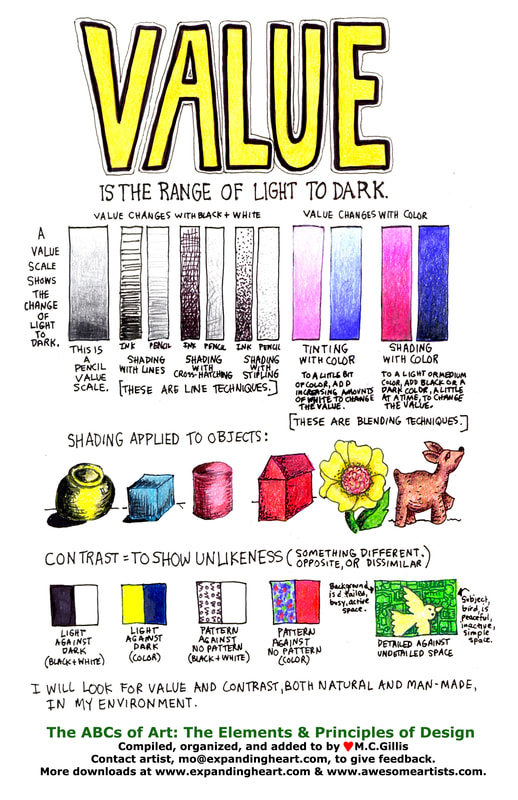Value
Video:
Adding Value Using Water Colors
Adding Value Using Colored Pencils
L
Vocabulary:
Value – In terms of art, value is the darkness or lightness of a color.
Tints – Tints are lighter values of a color.
Shades – Shades are darker values of a color.
Light Source – Location from which light is emitted.
Vocabulary:
Value – In terms of art, value is the darkness or lightness of a color.
Tints – Tints are lighter values of a color.
Shades – Shades are darker values of a color.
Light Source – Location from which light is emitted.
Assignments:
Project One Painting a Value Scale Using Primary Colors - PRINT
Materials - Red, yellow & blue tempera paint, paintbrush, water cup, black & white tempera paint.
1. Paint red in the 4th square.
2. Using black, add a dot of red (tip of paintbrush) to the black to create a very very dark red.
3. Paint the mixture in the 1st square.
4. Mixing an equal part of red & black, paint this mixture in the 2nd square.
5. Now add more red to the red & black mixture. Paint this in the 3rd square.
Rinse brush thoroughly.
6. Using white, add a dot of red (tip of paintbrush) to the white to create a very very light pink.
7. Paint this in the 8th square.
8. Mixing an equal part of red & white, paint this mixture in the 6th square.
9. Now in white, add a small amount of the red & white mixture and paint it in the 7th square.
Repeat all the steps above using yellow and blue. You should have a red value scale, yellow value scale and blue value scale when complete.
Project One Painting a Value Scale Using Primary Colors - PRINT
Materials - Red, yellow & blue tempera paint, paintbrush, water cup, black & white tempera paint.
1. Paint red in the 4th square.
2. Using black, add a dot of red (tip of paintbrush) to the black to create a very very dark red.
3. Paint the mixture in the 1st square.
4. Mixing an equal part of red & black, paint this mixture in the 2nd square.
5. Now add more red to the red & black mixture. Paint this in the 3rd square.
Rinse brush thoroughly.
6. Using white, add a dot of red (tip of paintbrush) to the white to create a very very light pink.
7. Paint this in the 8th square.
8. Mixing an equal part of red & white, paint this mixture in the 6th square.
9. Now in white, add a small amount of the red & white mixture and paint it in the 7th square.
Repeat all the steps above using yellow and blue. You should have a red value scale, yellow value scale and blue value scale when complete.
Project Two: Value Practice
On a black sheet of construction paper, practice creating a value scale using Prisma woodless colored pencils. Practice with at least three different colors.
On a black sheet of construction paper, practice creating a value scale using Prisma woodless colored pencils. Practice with at least three different colors.
Final Project 3: Value Landscape
Materials - Prisma woodless colored pencils or construction paper crayons, black construction paper.
1. Chose three different colors for the hills. Draw three overlapping hills.
2. Draw the horizontal line for the ground. Using different colors, divide the ground up into different sections.
3. Draw a circle in the sky for a moon or sun.
4. Using different colors, draw circles around the moon/sun until the sky is filled.
5. Using value coloring techniques, color in the landscape drawing.
See examples below.
Materials - Prisma woodless colored pencils or construction paper crayons, black construction paper.
1. Chose three different colors for the hills. Draw three overlapping hills.
2. Draw the horizontal line for the ground. Using different colors, divide the ground up into different sections.
3. Draw a circle in the sky for a moon or sun.
4. Using different colors, draw circles around the moon/sun until the sky is filled.
5. Using value coloring techniques, color in the landscape drawing.
See examples below.
This completes the Value Unit.





